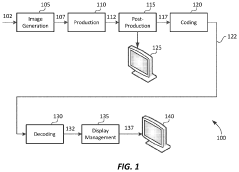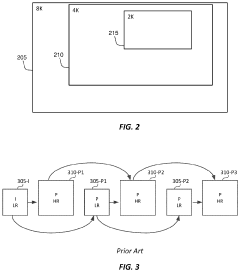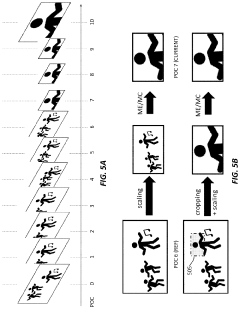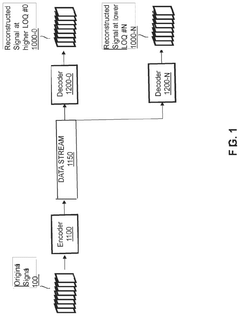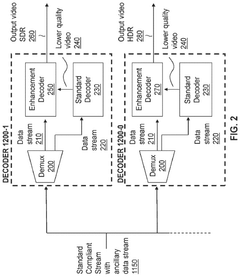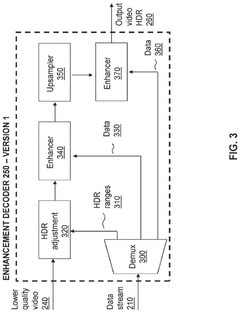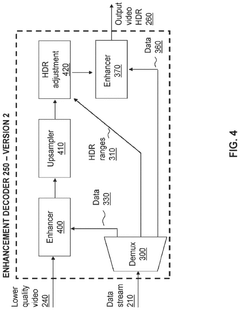Analysis of HDR10 vs Dolby Vision in Quantum Dot Technologies
OCT 24, 20259 MIN READ
Generate Your Research Report Instantly with AI Agent
Patsnap Eureka helps you evaluate technical feasibility & market potential.
HDR Technology Evolution and Objectives
High Dynamic Range (HDR) technology has evolved significantly since its inception in the early 2000s, transforming from a theoretical concept to a mainstream display feature. The journey began with the development of basic HDR rendering techniques in computer graphics, which later expanded into photography and eventually into video display technologies. By 2010, researchers had established the fundamental principles of HDR imaging, focusing on capturing and reproducing a wider range of luminance levels than traditional Standard Dynamic Range (SDR) technologies.
The evolution accelerated in 2014 when the first HDR-capable consumer displays entered the market, followed by the introduction of the HDR10 standard in 2015. This open standard represented a significant milestone, establishing baseline specifications for HDR content delivery across compatible devices. Dolby Vision emerged shortly after as a proprietary alternative, offering dynamic metadata capabilities that HDR10 initially lacked.
Quantum Dot technology integration with HDR represents another pivotal development in this timeline. First commercialized around 2013, Quantum Dot displays offered enhanced color volume and brightness capabilities that proved particularly complementary to HDR content. This synergy has driven continuous improvements in both technologies, with each iteration pushing the boundaries of visual fidelity.
The primary objective of modern HDR technology is to deliver a viewing experience that more closely resembles human visual perception of the natural world. This involves accurately reproducing a wider range of brightness levels (from deep blacks to brilliant highlights), expanded color gamut coverage, and improved contrast ratios. Specifically, HDR aims to overcome the limitations of traditional display technologies that compress the dynamic range of real-world scenes into the narrow capabilities of standard displays.
In the context of Quantum Dot technologies, HDR10 and Dolby Vision each pursue distinct technical objectives. HDR10 focuses on providing a standardized, widely compatible implementation that balances performance with practical deployment considerations. Its static metadata approach aims to deliver significant visual improvements while maintaining reasonable production and distribution costs.
Dolby Vision, conversely, prioritizes maximum visual quality through scene-by-scene or even frame-by-frame dynamic metadata adjustments. Its technical objective centers on optimizing the rendering of each content segment based on its specific characteristics and the display's capabilities, regardless of implementation complexity.
Looking forward, the technical evolution of both standards continues toward higher peak brightness capabilities, more precise local dimming solutions, and enhanced color accuracy—all while maintaining backward compatibility with existing content ecosystems. The ultimate goal remains creating increasingly realistic visual experiences that fully leverage the exceptional color purity and brightness potential of Quantum Dot display technologies.
The evolution accelerated in 2014 when the first HDR-capable consumer displays entered the market, followed by the introduction of the HDR10 standard in 2015. This open standard represented a significant milestone, establishing baseline specifications for HDR content delivery across compatible devices. Dolby Vision emerged shortly after as a proprietary alternative, offering dynamic metadata capabilities that HDR10 initially lacked.
Quantum Dot technology integration with HDR represents another pivotal development in this timeline. First commercialized around 2013, Quantum Dot displays offered enhanced color volume and brightness capabilities that proved particularly complementary to HDR content. This synergy has driven continuous improvements in both technologies, with each iteration pushing the boundaries of visual fidelity.
The primary objective of modern HDR technology is to deliver a viewing experience that more closely resembles human visual perception of the natural world. This involves accurately reproducing a wider range of brightness levels (from deep blacks to brilliant highlights), expanded color gamut coverage, and improved contrast ratios. Specifically, HDR aims to overcome the limitations of traditional display technologies that compress the dynamic range of real-world scenes into the narrow capabilities of standard displays.
In the context of Quantum Dot technologies, HDR10 and Dolby Vision each pursue distinct technical objectives. HDR10 focuses on providing a standardized, widely compatible implementation that balances performance with practical deployment considerations. Its static metadata approach aims to deliver significant visual improvements while maintaining reasonable production and distribution costs.
Dolby Vision, conversely, prioritizes maximum visual quality through scene-by-scene or even frame-by-frame dynamic metadata adjustments. Its technical objective centers on optimizing the rendering of each content segment based on its specific characteristics and the display's capabilities, regardless of implementation complexity.
Looking forward, the technical evolution of both standards continues toward higher peak brightness capabilities, more precise local dimming solutions, and enhanced color accuracy—all while maintaining backward compatibility with existing content ecosystems. The ultimate goal remains creating increasingly realistic visual experiences that fully leverage the exceptional color purity and brightness potential of Quantum Dot display technologies.
Market Analysis for Premium Display Technologies
The premium display technology market has witnessed substantial growth in recent years, primarily driven by increasing consumer demand for superior visual experiences across various platforms. The global premium display market, encompassing OLED, QLED, and other advanced technologies, reached approximately $115 billion in 2022 and is projected to grow at a CAGR of 7.8% through 2028. This growth trajectory is particularly evident in the quantum dot display segment, which has emerged as a significant competitor to traditional OLED displays.
Consumer preferences are increasingly shifting toward displays that offer enhanced color accuracy, brightness capabilities, and contrast ratios. This shift has catalyzed the adoption of HDR technologies, with HDR10 and Dolby Vision emerging as the dominant standards. Market research indicates that approximately 65% of premium television purchases now include HDR capability, with this percentage expected to increase as content availability expands.
The geographical distribution of market demand shows interesting patterns, with North America and Europe leading in premium display adoption, followed closely by the Asia-Pacific region. China has emerged as both a major consumer market and production hub, with domestic manufacturers rapidly gaining market share. Japan continues to maintain its position as a technology innovator, particularly in quantum dot advancements.
Industry segmentation reveals that the television sector dominates premium display technology adoption, accounting for 58% of the market. However, professional monitors, mobile devices, and automotive displays are experiencing the fastest growth rates, with compound annual growth exceeding 12% in these segments.
The competitive landscape features established players like Samsung, LG, and Sony maintaining leadership positions, while specialized manufacturers such as TCL and Hisense have made significant inroads through aggressive pricing strategies and technological partnerships. Samsung's quantum dot technology has positioned the company as the market leader in QLED displays, while LG maintains dominance in the OLED segment.
Content ecosystem development has become a critical market driver, with streaming platforms increasingly offering HDR content. Netflix, Amazon Prime, and Disney+ now provide substantial libraries of Dolby Vision and HDR10+ content, creating a positive feedback loop that further drives consumer adoption of compatible display technologies.
Price sensitivity analysis indicates that while premium displays command significant price premiums, the gap between standard and premium options has narrowed by approximately 22% over the past three years, making advanced technologies more accessible to mainstream consumers. This democratization of technology is expected to accelerate market growth and further intensify competition between HDR10 and Dolby Vision implementations in quantum dot displays.
Consumer preferences are increasingly shifting toward displays that offer enhanced color accuracy, brightness capabilities, and contrast ratios. This shift has catalyzed the adoption of HDR technologies, with HDR10 and Dolby Vision emerging as the dominant standards. Market research indicates that approximately 65% of premium television purchases now include HDR capability, with this percentage expected to increase as content availability expands.
The geographical distribution of market demand shows interesting patterns, with North America and Europe leading in premium display adoption, followed closely by the Asia-Pacific region. China has emerged as both a major consumer market and production hub, with domestic manufacturers rapidly gaining market share. Japan continues to maintain its position as a technology innovator, particularly in quantum dot advancements.
Industry segmentation reveals that the television sector dominates premium display technology adoption, accounting for 58% of the market. However, professional monitors, mobile devices, and automotive displays are experiencing the fastest growth rates, with compound annual growth exceeding 12% in these segments.
The competitive landscape features established players like Samsung, LG, and Sony maintaining leadership positions, while specialized manufacturers such as TCL and Hisense have made significant inroads through aggressive pricing strategies and technological partnerships. Samsung's quantum dot technology has positioned the company as the market leader in QLED displays, while LG maintains dominance in the OLED segment.
Content ecosystem development has become a critical market driver, with streaming platforms increasingly offering HDR content. Netflix, Amazon Prime, and Disney+ now provide substantial libraries of Dolby Vision and HDR10+ content, creating a positive feedback loop that further drives consumer adoption of compatible display technologies.
Price sensitivity analysis indicates that while premium displays command significant price premiums, the gap between standard and premium options has narrowed by approximately 22% over the past three years, making advanced technologies more accessible to mainstream consumers. This democratization of technology is expected to accelerate market growth and further intensify competition between HDR10 and Dolby Vision implementations in quantum dot displays.
Current HDR Standards and Technical Limitations
High Dynamic Range (HDR) technology has evolved significantly over the past decade, with several competing standards emerging in the market. Currently, the most prevalent HDR standards include HDR10, HDR10+, Dolby Vision, and Hybrid Log-Gamma (HLG). Each standard employs different technical approaches to expand the dynamic range and color gamut of display technologies.
HDR10, as an open standard, utilizes static metadata and supports 10-bit color depth, allowing for approximately 1.07 billion colors. It employs the Perceptual Quantizer (PQ) transfer function and can achieve peak brightness levels of 1,000 nits. However, HDR10's primary limitation lies in its static metadata approach, which applies the same brightness parameters throughout an entire content piece, potentially compromising scene-specific optimization.
Dolby Vision addresses this limitation through dynamic metadata implementation, enabling frame-by-frame or scene-by-scene optimization. Supporting up to 12-bit color depth (68.7 billion colors) and brightness levels reaching 10,000 nits, Dolby Vision offers superior technical capabilities. Nevertheless, its proprietary nature requires licensing fees, limiting widespread adoption compared to open standards like HDR10.
When applied to Quantum Dot display technologies, these HDR standards face unique challenges and opportunities. Quantum Dot displays excel at producing highly saturated colors and can achieve exceptional brightness levels, making them ideal candidates for HDR content reproduction. However, current technical limitations include color volume consistency across different brightness levels and potential color shifting at extreme viewing angles.
The integration of HDR standards with Quantum Dot technology also faces challenges in thermal management. As displays push toward higher peak brightness levels required by advanced HDR standards, quantum dots may experience efficiency degradation under prolonged high-temperature operation, affecting long-term performance stability and color accuracy.
Another significant limitation concerns content mastering inconsistencies. While Dolby Vision provides a more precise framework for content creation, the actual implementation varies widely across studios and content creators. This inconsistency creates challenges for display manufacturers attempting to optimize Quantum Dot displays for various HDR formats simultaneously.
Bandwidth constraints represent another technical hurdle, particularly for streaming services. Dolby Vision's additional metadata requirements increase bandwidth needs compared to HDR10, creating potential bottlenecks for content delivery systems, especially in regions with limited internet infrastructure.
Calibration complexity also presents challenges for both standards when implemented on Quantum Dot displays. The extended color gamut capabilities of Quantum Dots require sophisticated calibration procedures to ensure accurate color reproduction across the entire brightness range, with Dolby Vision's dynamic approach demanding even more complex calibration protocols.
HDR10, as an open standard, utilizes static metadata and supports 10-bit color depth, allowing for approximately 1.07 billion colors. It employs the Perceptual Quantizer (PQ) transfer function and can achieve peak brightness levels of 1,000 nits. However, HDR10's primary limitation lies in its static metadata approach, which applies the same brightness parameters throughout an entire content piece, potentially compromising scene-specific optimization.
Dolby Vision addresses this limitation through dynamic metadata implementation, enabling frame-by-frame or scene-by-scene optimization. Supporting up to 12-bit color depth (68.7 billion colors) and brightness levels reaching 10,000 nits, Dolby Vision offers superior technical capabilities. Nevertheless, its proprietary nature requires licensing fees, limiting widespread adoption compared to open standards like HDR10.
When applied to Quantum Dot display technologies, these HDR standards face unique challenges and opportunities. Quantum Dot displays excel at producing highly saturated colors and can achieve exceptional brightness levels, making them ideal candidates for HDR content reproduction. However, current technical limitations include color volume consistency across different brightness levels and potential color shifting at extreme viewing angles.
The integration of HDR standards with Quantum Dot technology also faces challenges in thermal management. As displays push toward higher peak brightness levels required by advanced HDR standards, quantum dots may experience efficiency degradation under prolonged high-temperature operation, affecting long-term performance stability and color accuracy.
Another significant limitation concerns content mastering inconsistencies. While Dolby Vision provides a more precise framework for content creation, the actual implementation varies widely across studios and content creators. This inconsistency creates challenges for display manufacturers attempting to optimize Quantum Dot displays for various HDR formats simultaneously.
Bandwidth constraints represent another technical hurdle, particularly for streaming services. Dolby Vision's additional metadata requirements increase bandwidth needs compared to HDR10, creating potential bottlenecks for content delivery systems, especially in regions with limited internet infrastructure.
Calibration complexity also presents challenges for both standards when implemented on Quantum Dot displays. The extended color gamut capabilities of Quantum Dots require sophisticated calibration procedures to ensure accurate color reproduction across the entire brightness range, with Dolby Vision's dynamic approach demanding even more complex calibration protocols.
Technical Comparison of HDR10 vs Dolby Vision Implementation
01 Quantum dot technology for enhanced color accuracy and gamut
Quantum dot technology enables displays to achieve superior color accuracy and wider color gamut compared to conventional display technologies. The nano-sized semiconductor particles emit precise wavelengths of light when excited, allowing for more accurate color reproduction. This technology significantly improves the display's ability to render colors accurately across the spectrum, which is essential for both HDR10 and Dolby Vision content. The quantum dots' narrow emission spectra result in purer colors and more precise color mapping.- Quantum dot technology for enhanced color gamut and accuracy: Quantum dot technology enables displays to achieve wider color gamuts and superior color accuracy compared to conventional display technologies. By precisely controlling the size of quantum dots, manufacturers can tune the emission wavelengths to produce highly saturated and accurate colors. This technology allows displays to meet the demanding color specifications required by HDR10 and Dolby Vision standards, resulting in more lifelike and vibrant images with improved color reproduction across the entire spectrum.
- HDR10 and Dolby Vision implementation with quantum dots: The implementation of HDR10 and Dolby Vision standards in quantum dot displays involves specialized signal processing and color mapping algorithms. These high dynamic range formats require displays capable of rendering both extremely bright highlights and deep blacks simultaneously, while maintaining color accuracy throughout the brightness range. Quantum dot technology enables displays to meet these requirements by providing high peak brightness levels while preserving color volume at all luminance levels, resulting in more detailed images with greater contrast and depth.
- Brightness enhancement and local dimming techniques: Quantum dot displays achieve superior brightness levels through various enhancement techniques and local dimming technologies. By combining quantum dots with advanced backlight systems, these displays can deliver significantly higher peak brightness while maintaining energy efficiency. Local dimming allows for precise control of backlight zones, enhancing contrast by dimming areas that should appear dark while maintaining brightness in highlight areas. These techniques are essential for properly rendering HDR content that requires both high peak brightness and deep black levels simultaneously.
- Quantum dot film and layer structures for display applications: The physical implementation of quantum dots in display systems involves specialized film and layer structures. These include quantum dot enhancement films (QDEF), on-chip quantum dot solutions, and quantum dot color filters. The arrangement and composition of these layers significantly impact display performance metrics such as brightness, color accuracy, and viewing angles. Advanced manufacturing techniques ensure uniform distribution of quantum dots throughout the display, preventing color inconsistencies and ensuring optimal performance for HDR10 and Dolby Vision content.
- Calibration and image processing for quantum dot displays: Sophisticated calibration and image processing algorithms are essential for optimizing quantum dot displays for HDR10 and Dolby Vision content. These algorithms include color mapping, tone mapping, and dynamic range adaptation to ensure accurate reproduction of content across different brightness levels. Advanced processing techniques compensate for the unique characteristics of quantum dot emission, ensuring consistent color accuracy throughout the display's brightness range. These calibration methods are crucial for maintaining the creator's intended visual experience when viewing high dynamic range content.
02 HDR10 and Dolby Vision implementation with quantum dots
Quantum dot displays can be specifically optimized for HDR10 and Dolby Vision standards by enhancing brightness levels and contrast ratios. The implementation involves specialized signal processing algorithms that map content to the display's capabilities while preserving the creative intent. Dolby Vision's dynamic metadata allows for frame-by-frame optimization, while HDR10 uses static metadata for the entire content. Quantum dots enable the high peak brightness and deep black levels required by these HDR standards, resulting in more immersive viewing experiences with greater detail in both bright and dark scenes.Expand Specific Solutions03 Brightness enhancement techniques for quantum dot displays
Various techniques are employed to enhance brightness levels in quantum dot displays, which is crucial for HDR content. These include optimized backlight designs, light-guiding structures, and quantum dot film configurations that maximize light extraction efficiency. Advanced thermal management systems prevent brightness degradation at high luminance levels. Some implementations use local dimming technologies to achieve higher peak brightness while maintaining energy efficiency. These brightness enhancement methods are essential for meeting the demanding specifications of HDR10 and Dolby Vision content.Expand Specific Solutions04 Color calibration and management systems for quantum dot displays
Sophisticated color calibration and management systems are implemented in quantum dot displays to ensure accurate color reproduction across different content types. These systems include factory calibration processes, real-time color correction algorithms, and adaptive color mapping based on ambient lighting conditions. Some implementations use AI-based color management to optimize display parameters for different viewing environments. These systems ensure that the wide color gamut capabilities of quantum dots are properly utilized while maintaining color accuracy according to industry standards for both HDR10 and Dolby Vision content.Expand Specific Solutions05 Quantum dot composition and manufacturing for display applications
Advanced quantum dot compositions and manufacturing techniques are developed specifically for display applications requiring high brightness and color accuracy. These include core-shell structures that improve quantum yield and stability, surface treatments that enhance light emission efficiency, and encapsulation methods that protect quantum dots from environmental degradation. Some implementations use quantum dot materials optimized for specific wavelengths to achieve precise color points required by display standards. Manufacturing processes focus on producing uniform quantum dot sizes and distributions to ensure consistent color performance across the display panel.Expand Specific Solutions
Key Industry Players in HDR and Quantum Dot Ecosystem
The HDR10 vs Dolby Vision competition in Quantum Dot Technologies is currently in a growth phase, with the market expanding rapidly as display technologies mature. Major players like Dolby Laboratories, Samsung Electronics, and TCL China Star Optoelectronics are driving innovation in this space. Dolby Vision offers dynamic metadata advantages, while HDR10 maintains broader compatibility across devices. Technology maturity varies between companies, with Dolby leading proprietary solutions while Samsung, Sony, and Apple have developed significant implementation expertise. Other contributors include Philips, OPPO, and research institutions like KAIST and Electronics & Telecommunications Research Institute, creating a competitive ecosystem balancing proprietary technologies with open standards.
Dolby Laboratories Licensing Corp.
Technical Solution: Dolby Vision represents Dolby's premium HDR technology that delivers superior image quality through dynamic metadata, enabling frame-by-frame optimization. Unlike static HDR10, Dolby Vision supports up to 12-bit color depth (68 billion colors) and peak brightness of 10,000 nits, significantly exceeding HDR10's 10-bit depth (1 billion colors) and 1,000 nits brightness capability. When integrated with Quantum Dot displays, Dolby Vision leverages the expanded color gamut (up to 93% of Rec. 2020) and enhanced brightness capabilities to deliver more accurate color mapping across the entire luminance range. The technology employs sophisticated algorithms that analyze content characteristics and adjust display parameters in real-time, ensuring optimal presentation regardless of viewing environment or display capabilities. Dolby Vision's dual-layer approach processes both standard and high dynamic range information simultaneously, preserving artistic intent while maximizing display performance.
Strengths: Superior dynamic range with frame-by-frame metadata optimization; better color accuracy with 12-bit processing; greater future-proofing with higher technical specifications; consistent quality across different displays through intelligent mapping. Weaknesses: Requires licensing fees increasing product costs; more processing power needed for decoding; limited content availability compared to HDR10; requires end-to-end implementation from content creation to display.
Koninklijke Philips NV
Technical Solution: Philips has pioneered significant advancements in quantum dot display technology with their "QDLED" approach that combines quantum dots with LED backlighting systems. Their HDR implementation focuses on compatibility with both HDR10 and HDR10+ standards (which Philips co-developed with Samsung and others). Philips' P5 processing engine specifically addresses the challenges of rendering HDR content on quantum dot displays by employing a multi-step enhancement process that includes source optimization, color enhancement, contrast optimization, sharpness improvement, and motion handling. For quantum dot displays, Philips has developed specialized algorithms that analyze the incoming HDR signal (whether HDR10 or Dolby Vision) and optimize light output across different zones of the display, taking advantage of quantum dots' ability to produce pure, saturated colors even at high brightness levels. Their Ambilight technology further enhances perceived contrast by projecting complementary colors around the display, creating a more immersive HDR viewing experience that extends beyond the physical screen boundaries.
Strengths: Strong processing capabilities through P5 engine; innovative Ambilight technology enhances perceived HDR quality; good balance between performance and cost; support for multiple HDR standards. Weaknesses: Less peak brightness compared to some competitors; processing can sometimes appear artificial; quantum dot implementation not as advanced as Samsung's; limited premium models with full HDR capabilities.
Patent Landscape for HDR and Quantum Dot Integration
Video coding using reference picture resampling supporting region of interest
PatentActiveUS20220286667A1
Innovation
- The implementation of reference picture resampling (RPR) with support for region of interest (ROI) in video coding, allowing for flexible scaling and decoding of specific regions within a video frame, enabling scalable distribution of HDR content compatible with various display resolutions and devices.
Colour conversion within a hierarchical coding scheme
PatentActiveUS12120305B2
Innovation
- A hierarchical coding scheme that allows for the encoding and decoding of HDR-type signals in a way that enables compatibility with both HDR and SDR displays, using a method that involves converting input signals between color spaces, down-sampling, and adding ancillary data for reconstruction, thereby providing backwards compatibility and reduced bandwidth requirements.
Content Creation Pipeline for HDR Technologies
The content creation pipeline for HDR technologies represents a critical workflow that determines how effectively HDR content can be produced, processed, and delivered to end consumers. For both HDR10 and Dolby Vision implementations in quantum dot displays, the pipeline begins with content capture using high dynamic range capable cameras that can record significantly wider luminance ranges than traditional equipment.
In HDR10 workflows, content is typically captured in 10-bit color depth with static metadata that defines the overall brightness parameters for the entire content. This approach requires less processing overhead but limits scene-by-scene optimization. Content creators working with HDR10 must carefully balance the overall dynamic range to ensure acceptable performance across all scenes, sometimes resulting in creative compromises.
Dolby Vision, conversely, employs a more sophisticated pipeline that supports 12-bit color depth and dynamic metadata capabilities. This allows brightness parameters to be adjusted on a frame-by-frame or scene-by-scene basis, providing greater creative control. Content creators can specify precise luminance values for each scene, ensuring optimal presentation regardless of content variations throughout a program.
When specifically considering quantum dot displays, the content creation pipeline must account for the expanded color gamut capabilities these technologies offer. Color grading for quantum dot displays requires careful calibration to take advantage of the wider color volume while maintaining color accuracy. Dolby Vision's pipeline includes specific tools for mapping content to the capabilities of quantum dot displays, while HDR10 requires more manual intervention to achieve optimal results.
Post-production workflows differ significantly between the two standards. HDR10 typically involves a single master that must work across all compatible displays, while Dolby Vision creates a high-quality master that can be dynamically adapted to different display capabilities through its intelligent tone mapping algorithms. This difference is particularly relevant for quantum dot displays, which can exhibit varying peak brightness and color volume specifications across different manufacturers and models.
Distribution considerations also impact the pipeline, with HDR10 content requiring less bandwidth due to its simpler metadata structure, while Dolby Vision's additional data necessitates slightly higher bitrates to maintain its enhanced capabilities. Content creators must weigh these factors when determining which HDR format to prioritize for quantum dot display optimization.
In HDR10 workflows, content is typically captured in 10-bit color depth with static metadata that defines the overall brightness parameters for the entire content. This approach requires less processing overhead but limits scene-by-scene optimization. Content creators working with HDR10 must carefully balance the overall dynamic range to ensure acceptable performance across all scenes, sometimes resulting in creative compromises.
Dolby Vision, conversely, employs a more sophisticated pipeline that supports 12-bit color depth and dynamic metadata capabilities. This allows brightness parameters to be adjusted on a frame-by-frame or scene-by-scene basis, providing greater creative control. Content creators can specify precise luminance values for each scene, ensuring optimal presentation regardless of content variations throughout a program.
When specifically considering quantum dot displays, the content creation pipeline must account for the expanded color gamut capabilities these technologies offer. Color grading for quantum dot displays requires careful calibration to take advantage of the wider color volume while maintaining color accuracy. Dolby Vision's pipeline includes specific tools for mapping content to the capabilities of quantum dot displays, while HDR10 requires more manual intervention to achieve optimal results.
Post-production workflows differ significantly between the two standards. HDR10 typically involves a single master that must work across all compatible displays, while Dolby Vision creates a high-quality master that can be dynamically adapted to different display capabilities through its intelligent tone mapping algorithms. This difference is particularly relevant for quantum dot displays, which can exhibit varying peak brightness and color volume specifications across different manufacturers and models.
Distribution considerations also impact the pipeline, with HDR10 content requiring less bandwidth due to its simpler metadata structure, while Dolby Vision's additional data necessitates slightly higher bitrates to maintain its enhanced capabilities. Content creators must weigh these factors when determining which HDR format to prioritize for quantum dot display optimization.
Consumer Experience and Adoption Factors
Consumer adoption of HDR technologies in quantum dot displays is primarily driven by the perceived visual quality enhancement and the overall viewing experience. Research indicates that when presented with side-by-side comparisons, consumers consistently rate Dolby Vision content higher than HDR10 in terms of perceived image quality, color accuracy, and contrast performance. This preference becomes particularly pronounced in scenes with complex lighting conditions or high dynamic range requirements.
The adoption curve for these technologies follows distinct patterns across different market segments. Early adopters and technology enthusiasts demonstrate greater awareness of the technical differences between HDR10 and Dolby Vision, often making purchasing decisions based on specific format support. However, the mainstream consumer market shows less technical discrimination, with purchasing decisions more heavily influenced by brand recognition, price point, and general "HDR capability" rather than specific format implementation.
Content availability serves as a critical factor in consumer adoption. While HDR10 enjoys broader support across streaming platforms and physical media, Dolby Vision's growing presence on premium content from major studios creates a compelling value proposition for consumers who prioritize cinematic experiences. The fragmentation of content across different HDR formats has created some consumer confusion, potentially slowing adoption rates among less technically-oriented market segments.
Price sensitivity analysis reveals that consumers demonstrate varying willingness to pay premium prices for Dolby Vision-capable quantum dot displays. The premium pricing threshold appears to be approximately 15-20% above comparable HDR10-only models, beyond which adoption rates decline significantly. This price sensitivity is less pronounced in high-end market segments where Dolby Vision is increasingly positioned as an expected feature rather than a premium option.
User interface and experience factors significantly impact consumer perception of HDR technologies. Displays that clearly indicate HDR format activation and provide intuitive controls for HDR settings receive higher consumer satisfaction ratings. The automatic tone mapping capabilities of Dolby Vision provide a notable advantage in this regard, as they reduce the need for manual calibration across different content types.
Long-term adoption trends suggest that as quantum dot technology continues to mature and manufacturing costs decrease, the premium associated with Dolby Vision support will likely diminish, potentially accelerating mainstream adoption. However, the continued evolution of HDR standards and the potential introduction of new formats may create additional market fragmentation and consumer hesitation in the near term.
The adoption curve for these technologies follows distinct patterns across different market segments. Early adopters and technology enthusiasts demonstrate greater awareness of the technical differences between HDR10 and Dolby Vision, often making purchasing decisions based on specific format support. However, the mainstream consumer market shows less technical discrimination, with purchasing decisions more heavily influenced by brand recognition, price point, and general "HDR capability" rather than specific format implementation.
Content availability serves as a critical factor in consumer adoption. While HDR10 enjoys broader support across streaming platforms and physical media, Dolby Vision's growing presence on premium content from major studios creates a compelling value proposition for consumers who prioritize cinematic experiences. The fragmentation of content across different HDR formats has created some consumer confusion, potentially slowing adoption rates among less technically-oriented market segments.
Price sensitivity analysis reveals that consumers demonstrate varying willingness to pay premium prices for Dolby Vision-capable quantum dot displays. The premium pricing threshold appears to be approximately 15-20% above comparable HDR10-only models, beyond which adoption rates decline significantly. This price sensitivity is less pronounced in high-end market segments where Dolby Vision is increasingly positioned as an expected feature rather than a premium option.
User interface and experience factors significantly impact consumer perception of HDR technologies. Displays that clearly indicate HDR format activation and provide intuitive controls for HDR settings receive higher consumer satisfaction ratings. The automatic tone mapping capabilities of Dolby Vision provide a notable advantage in this regard, as they reduce the need for manual calibration across different content types.
Long-term adoption trends suggest that as quantum dot technology continues to mature and manufacturing costs decrease, the premium associated with Dolby Vision support will likely diminish, potentially accelerating mainstream adoption. However, the continued evolution of HDR standards and the potential introduction of new formats may create additional market fragmentation and consumer hesitation in the near term.
Unlock deeper insights with Patsnap Eureka Quick Research — get a full tech report to explore trends and direct your research. Try now!
Generate Your Research Report Instantly with AI Agent
Supercharge your innovation with Patsnap Eureka AI Agent Platform!
